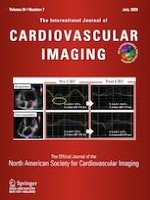Published in:

01-07-2020 | Stroke | Original Paper
Characterization of Fabry Disease cardiac involvement according to longitudinal strain, cardiometabolic exercise test, and T1 mapping
Authors:
Patricia Réant, Emilie Testet, Amélie Reynaud, Catherine Bourque, Matthieu Michaud, Caroline Rooryck, Cyril Goizet, Didier Lacombe, Valérie de-Précigout, Jérôme Peyrou, Hubert Cochet, Stéphane Lafitte
Published in:
The International Journal of Cardiovascular Imaging
|
Issue 7/2020
Login to get access
Abstract
In Anderson-Fabry disease (FD), we sought to evaluate relation between left ventricular (LV) hypertrophy, longitudinal strain (LS), myocardial T1 mapping and cardiopulmonary exercise parameters, and their prognostic value in term of cardiovascular outcomes. In this prospective, observational, monocentric study called “FABRY-Image”, we evaluated consecutive adult FD patients by echocardiography, cardiac magnetic resonance, and cardiopulmonary exercise testing. We investigated regional LS, the relations between LV hypertrophy, LS, T1 mapping, and VO2 peak and VE/VCO2, and the prediction of cardiovascular events during follow-up. From 2016 to 2019, we included 35 FD patients (44 ± 17 years, 40% male), that were compared with 20 controls. In FD patients, global, basal and mid-LV LS, as well as mean T1 were significantly altered compared to controls (p < 0.05) with relative apical LS sparing. LV wall thickness was particularly related to mean of basal LS (r = − 0.73), to T1 (r = − 0.48), and to VE/VCO2 (r = 0.45). Mean of basal LS was well related to myocardial T1 (r = 0.59). A good relation was observed between VO2 peak and global LS (r = 0.39) while VE/VCO2 slope was more related to maximal LV wall thickness (r = 0.45), and T1 (r = − 0.61). During a median follow-up of 2.4 years, 6/31 patients presented de novo atrial fibrillation or stroke. In Cox univariate analyses, LV wall thickness, basal LS, T1 value, and VE/VCO2 were significantly predictive of occurrence of de novo atrial fibrillation or stroke (p < 0.05). Our study shows an apical LS sparing in FD patients as observed in amyloidosis, and a close relation between LV hypertrophy, LS, T1 mapping, and VE/VCO2 which are all associated to the occurrence of de novo atrial fibrillation or TIA/stroke during follow-up. These results need to be confirmed by future multicentric studies.





